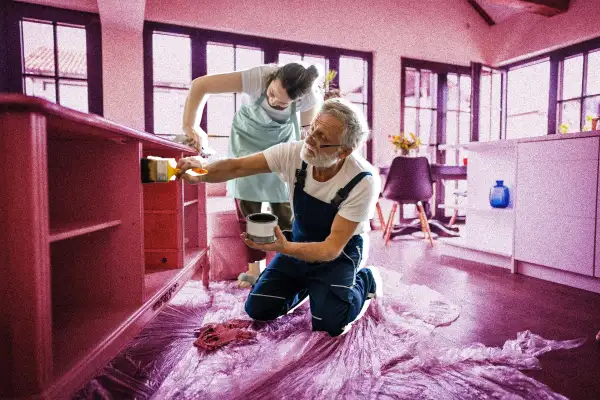5 Areas of Your Home to Renovate Before Retiring

After a lifetime of work, retirement should be a time for relaxing: slow mornings, new hobbies, travel and quality time with loved ones. One thing that can add stress? Struggling to go about your daily tasks in your own home.
For many retirees, this scenario isn't far-fetched. About 2 in 5 adults over 65 have mobility issues or some other form of disability, and most homes in the U.S. aren't built with them in mind. In fact, just 4% of the housing stock nationwide is built to accommodate aging adults, according to researcher Nancy Berlinger, who focuses on aging populations at The Hastings Center, a bioethics research institute.
This is out of balance with what most people want. According to AARP's Home and Community Preferences Survey, as many as 75% of adults over 50 want to age in their own homes. If this resonates with you, you'll likely need to invest in key upgrades that will allow you to complete daily tasks like bathing and cooking, even if your mobility declines.
5 areas every retiree should consider updating
Fortunately, preparing your home for the long haul doesn't always mean taking on a major construction project. Many renovations that can significantly improve your day-to-day living are relatively affordable and easily done by a handyman. Here’s where to get started:
Bathroom
The first room up for review is the bathroom — it's one of the most frequently used areas of the home and where most falls occur.
"If you've got a limited budget, bathrooms are going to be the number one priority," says Dak Kopec, architectural psychologist and professor at the University of Nevada, Las Vegas.
This is especially true in older homes where bathrooms tend to be smaller. As people age, they often lose the balance and mobility that helped them move in these small spaces with ease — they need more space to maneuver and pivot, Kopec says.
Falls are more common when you have to lift your legs to step into a bathtub, so curbless or threshold-free shower stalls are best. Ideally, the shower should also have a bench affixed to the wall so that you can shower while seated.
Other minor fixes include installing grab bars, replacing shower heads with handheld nozzles and installing faucet lever handles. (These are much easier to grip and open than knobs.)
Kitchen
The goal in the kitchen is to create a workspace where you won’t get as tired out while preparing food. Think: adding rollout trays or lazy Susans to bottom cabinets so you can grab items more easily. You can also install glass-front cabinet doors to improve visibility and integrate pull-down shelves into existing upper cabinets. These shelves fit seamlessly into the cabinet space and extend your items to a lower height so everything is within reach, not above you.
More complex renovations include removing bottom cabinets to accommodate a wheelchair and lowering kitchen countertops to a height that's comfortable for wheelchair users, both of which may require custom-made carpentry. Finally, look for dark corners that may need new lights and consider installing ergonomic rocker light switches, which are easier on people with arthritis.
Entryways and hallways
In the past, most people didn't live long enough to need mobility aids, so homes weren't built to accommodate a wheelchair or a walker.
Advancements in medicine and the technology of mobility aids have changed that. About 7 in 100 older adults in the U.S. use a wheelchair, according to data gathered by the National Health and Aging Trends Study (NHATS), and the likelihood of needing a wheelchair increases as you age.
Homeowners who use walkers or wheelchairs need hallways with enough clearance to move comfortably. Entryways need to be at least 36 inches wide, and there should also be at least one way to enter and exit the house using a wheelchair — either a permanent ramp or angled entry plates fixed to the floor.
Flooring
The right flooring material ultimately depends on your individual needs. But there is a universal rule, Kopec says: “The problem is having non-affixed flooring.”
Any flooring material that isn't hammered down to the floor is a hazard, with area rugs being the most common issue. Not only are they trip hazards for people walking, but the rug can crumple and get caught in the wheels of a wheelchair, causing it to tip over. This doesn't mean that you have to stick to one type of flooring material. You can have tiled and carpeted areas throughout the home, but they shouldn’t create stumbling hazards where they meet.
Finally, evaluate the areas where you'd have to step up to continue walking — these are typically doorways and changes in floor level. These small changes in elevation may seem inconsequential now but pose a risk of falls once your mobility and balance decline. To minimize this risk, you can install angled mats or small ramps made of metal or rubber.
Layout of the home
Multi-story homes pose a challenge for aging in place. As you age, walking up a flight of stairs to reach the bedroom or taking laundry down to a basement becomes difficult — if not dangerous.
The first step is to evaluate whether you can move every essential living area to the first floor of your home. If your bathroom, bedroom, laundry room and kitchen are on a single story, you can carry out most of your day-to-day activities without climbing stairs.
Another option is installing an electric stair lift— a device that carries you up and down the stairs in a seated position. That said, the usefulness of this device depends on your ability to get in and out of the seat, and whether it can hold your weight. Wheelchair users or people who need some sort of mobility assistance at all times may need to install a residential elevator, which can set you back anywhere from $10,000 to $70,000.
Deciding between a stairlift, elevator, and single-story living depends on your budget and the complexity of the project. Single-story living could be a simple shift if all you have to do is move some furniture around or a massive renovation if you have to expand a bedroom or build a bathroom from scratch. In some cases, it may make more financial sense to sell and move into a new home that's already built with accessibility in mind.
How much do home improvements for aging in place cost?
The cost of home improvements varies greatly by geographic area, the age of the home, the professionals hired to complete it and naturally, the size of the project.
According to the home services website Angie's List, installing specific accessibility features can range from $700 to $8,000. This includes projects like widening hallways and doorways, installing grab bars, and upgrading kitchens and bathrooms to meet guidelines set by the Americans with Disabilities Act (ADA).
Of course, a complete renovation of areas like the kitchen or bathroom can set you back thousands of dollars more, especially if you hire an interior designer or architect. Depending on the scope of the project, Angie’s List reports that a kitchen remodel ranges from $15,000 to $41,000. Most bathroom remodels cost between $7,000 and $18,000 though it's not uncommon for some projects to cost double that.
Many homeowners tap into their home equity to finance more major bathroom and kitchen remodels. The most popular options are home equity loans and home equity lines of credit, but if you’ve already left full-time work, it may be hard to get approved by a traditional lender if you don’t have a solid income from Social Security, pensions or investment accounts. If that’s the case, try looking for financing designed for older adults, like a specialty home loan or line of credit, or a reverse mortgage.
Kate Granigan, CEO of care management firm LifeCare Advocates, says residents may also qualify for grants depending on their financial need or if a particular health condition prompts the renovations. Another option is to seek low-cost loans through nonprofit or disease-specific organizations.
One such program is CAPABLE, which was developed by the Johns Hopkins School of Nursing for adults aged 60 years or older who want to age in their community but who face difficulties completing daily activities like bathing, eating or moving around the home. The program sends an occupational therapist, a nurse and a handyman who collaborate with homeowners to improve their living conditions. Solutions are individually tailored and range from teaching participants how to get out of a bathtub safely to providing home repairs and assistive devices like a stair lift or a walker.
Tips for successful home renovations for aging in place
You can start planning for home updates for retirement by reviewing the National Association of Home Builder's aging-in-place remodeling checklist and comparing it to the current state of your home. Then, these tips can also help you navigate the renovation process with confidence:
Make these changes before you need them
Home renovations are an easier undertaking when you're young(er) and mobile, not when there's an emerging health problem. Plus, you'll have more financial flexibility if you start renovating your home while you’re still working. Because most retirees are living on a fixed income, they tend to be very price-sensitive and resistant to taking on new expenses once they’ve left the labor force, Berlinger says.
Leave space for the unexpected
There are ways to design for what you need now while still leaving room to redesign as your needs change. This doesn't mean you have to anticipate every possible ailment, but there's value in considering the big picture — if, for example, you need a wheelchair 10 or 20 years down the road, you'll be glad you invested in wider entryways now.
"Remember that aging lasts a long time," Berlinger says.
To help people grasp the changes their bodies may undergo as they age, she likes to remind them that the age gap between a newborn and a 30-year-old is the same as between someone who is 65 and 95 years old. A lot can shift in 30 years, and smart home design can accommodate these changes.
Know that costs depend on when the home was built
Kopec says that integrating aging-friendly custom features when building a new home can add around 10% to the final cost. Renovations, on the other hand, tend to be more expensive in older homes because they require structural changes as well as upgrades in plumbing and electricity.
"If the home was built before the 1960s, it's going to be more expensive to renovate anything," he says. A $50,000 renovation budget may only get you a shower remodel, but that same budget can stretch for a complete bathroom remodel and maybe the hallway if the home was built in the 1980s or 1990s. The money can go even further in more modern homes.
Invest in custom-built upgrades when possible
For a bathroom update, you can go to a home improvement store, buy a shower seat and a couple of grab bars and call it a day. But custom-built designs are often a better option (and not as expensive as you might think). For starters, the object doesn't move around — a real risk if you purchase a standalone shower seat instead of affixing one to the shower wall, for example.
Custom upgrades also allow you to factor in each person's body proportions. For example, a fold-out seat affixed to a kitchen island — a place where you can sit while you prep food — will need to be set at a different height depending on your measurements.
Built-in upgrades aren't always luxuries reserved for homeowners with a large budget. A fold-out seat like the one mentioned above is a modification a handyman can easily do, and it's much better than buying a bench or stool that can tip over, Kopec says.
Get input from a professional
You can work with an occupational therapist, an interior designer and a contractor to create a functional home improvement plan that fits your preferences and budget.
Start by searching the National Home Builders Association directory to identify certified aging-in-place specialists (CAPS) in your area. A CAPS designation tells you the builder has completed professional development courses focused on aging in place so they can provide more targeted advice to your needs.
Editor’s note: This story was originally reported and published in October 2024. We’ve updated it to feature more current information.
More from Money:
How to Rebalance Your Investments Ahead of (and During) Retirement
Here's Who Actually Needs Long-Term Care Insurance — and When to Buy It
How Much Money Do You Need to Retire? Answer These 4 Questions to Find Out





